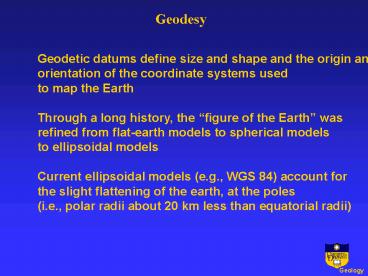Geodesy - PowerPoint PPT Presentation
1 / 8
Title: Geodesy
1
Geodesy
Geodetic datums define size and shape and the
origin and orientation of the coordinate systems
used to map the Earth Through a long history,
the figure of the Earth was refined from
flat-earth models to spherical models to
ellipsoidal models Current ellipsoidal models
(e.g., WGS 84) account for the slight flattening
of the earth, at the poles (i.e., polar radii
about 20 km less than equatorial radii)
Geology
2
Reference Ellipsoids
A variety of ellipsoids have been developed over
time, at present WGS 84 is most commonly used
Geology
3
Earth Surfaces
Ellipsoid Surface as defined by reference
ellipsoids Topographic Surface actual sea-level
and height above sea-level Geoid Surface
predicted height of surface due to gravity alone
Geology
4
WGS 84 Geoid
WGS 84 Geoid defines geoid heights for the entire
Earth GPS (Global Positioning System) is based on
WGS 84
Geology
5
Latitude and Longitude
Prime Meridian and Equator are reference planes
used to define latitude and longitude
Geodetic latitude is the angle from equatorial
plane to vertical direction of line normal
to reference ellipsoid
Geology
6
Universal Transverse Mercator (UTM)
UTM coordinates define two dimensional, horizontal
positions (e.g., northings and eastings)
Geology
7
UTM Coordinates
Eastings (x) are measured from the central
meridian of each zone (with a 500 km false
easting to ensure positive values Northings (y)
are measured from the equator with a 10,000 km
false northing for positions south of the equator
Geology
8
State Plane Coordinates
State Plane systems developed to provide local
reference systems tied to a national
datum Similar to UTM, a two-dimensional
coordinate system NAD 27 system in feet NAD
83 system in meters e.g., Coast Guard maintains
a network of differential monitors and transmits
corrections along coastline
Geology































